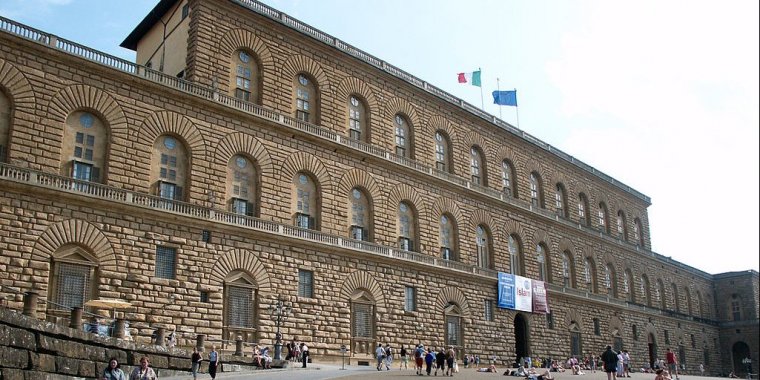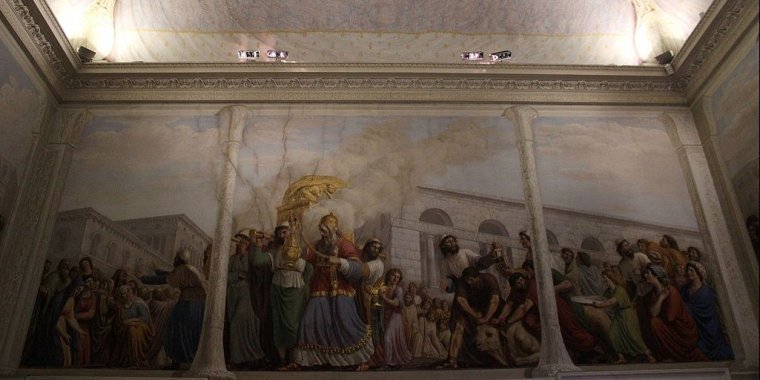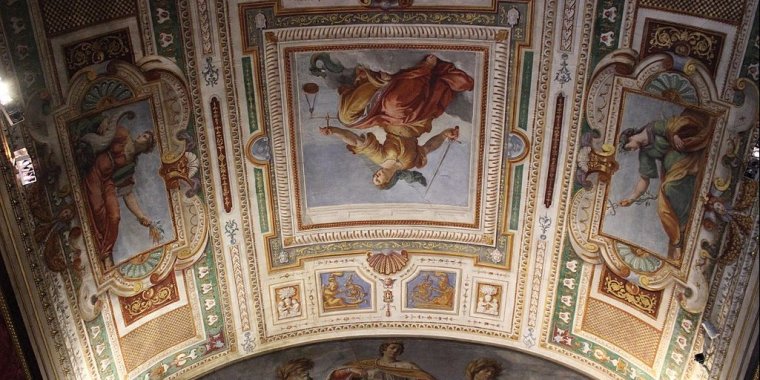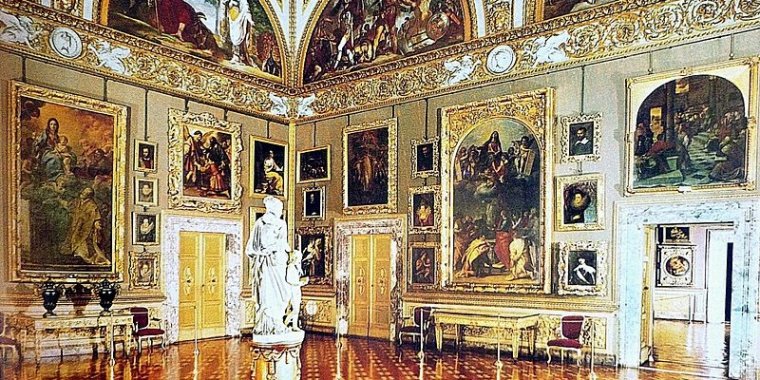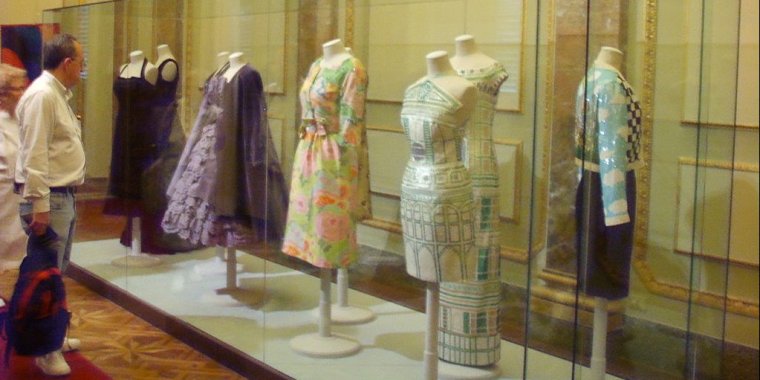| Travel / Tourist Attractions |
Palazzo Pitti, Florence, Italy
The Palazzo Pitti, in English sometimes called the Pitti Palace, is a vast, mainly Renaissance, palace in Florence, Italy. It is situated on the south side of the River Arno, a short distance from the Ponte Vecchio. The core of the present palazzo dates from 1458 and was originally the town residence of Luca Pitti, an ambitious Florentine banker.
The palace was bought by the Medici family in 1549 and became the chief residence of the ruling families of the Grand Duchy of Tuscany. It grew as a great treasure house as later generations amassed paintings, plates, jewelry and luxurious possessions.
In the late 18th century, the palazzo was used as a power base by Napoleon and later served for a brief period as the principal royal palace of the newly united Italy. The palace and its contents were donated to the Italian people by King Victor Emmanuel III in 1919.
The palazzo is now the largest museum complex in Florence. The principal palazzo block, often in a building of this design known as the corps de logis, is 32,000 square metres. It is divided into several principal galleries or museums.
The Palatine Gallery, the main gallery of Palazzo Pitti, contains a large ensemble of over 500 principally Renaissance paintings, which were once part of the Medicis' and their successors' private art collection. The gallery, which overflows into the royal apartments, contains works by Raphael, Titian, Perugino (Lamentation over the Dead Christ), Correggio, Peter Paul Rubens, and Pietro da Cortona.
The character of the gallery is still that of a private collection, and the works of art are displayed and hung much as they would have been in the grand rooms for which they were intended rather than following a chronological sequence, or arranged according to school of art.
The finest rooms were decorated by Pietro da Cortona in the high baroque style. Initially Cortona frescoed a small room on the piano nobile called the Sala della Stufa with a series depicting the Four Ages of Man which were very well received; the Age of Gold and Age of Silver were painted in 1637, followed in 1641 by the Age of Bronze and Age of Iron.
They are regarded among his masterpieces. The artist was subsequently asked to fresco the grand ducal reception rooms; a suite of five rooms at the front of the palazzo. In these five Planetary Rooms, the hierarchical sequence of the deities is based on Ptolomeic cosmology; Venus, Apollo, Mars, Jupiter (the Medici Throne room) and Saturn, but minus Mercury and the Moon which should have come before Venus.
These highly ornate ceilings with frescoes and elaborate stucco work essentially celebrate the Medici lineage and the bestowal of virtuous leadership. Cortona left Florence in 1647, and his pupil and collaborator, Ciro Ferri, completed the cycle by the 1660s. They were to inspire the later Planet Rooms at Louis XIV's Versailles, designed by Le Brun.
The collection was first opened to the public in the late 18th century, albeit rather reluctantly, by Grand Duke Leopold, Tuscany's first enlightened ruler, keen to obtain popularity after the demise of the Medici.
The Palatine Gallery has 28 rooms, among them:
• Room of Castagnoli: named after the painter of the ceiling frescoes. In this room are exposed Portraits of the Medici and Lorraine ruling families, and the Table of the Muses, a masterwork of stone-inlaid table realized by the Opificio delle Pietre Dure between 1837 and 1851.
• Room of the Ark: contains a painting by Giovan Battista Caracciolo (17th century). In 1816, the ceiling was frescoed by Luigi Ademollo with Transportation of the Ark of the Covenant Containing the Tablets of the Law.
• Room of Psyche: was named after ceiling frescoes by Giuseppe Collignon; it contains paintings by Salvator Rosa from 1640–1650.
• Hall of Poccetti: The frescoes on the vault were once ascribed to Bernardino Poccetti, but now attributed to Matteo Rosselli. In the center of the hall is a table (1716) commissioned by Cosimo III. In the hall are also some works by Rubens and Pontormo.
• Room of Prometheus: was named after the subject of the frescoes by Giuseppe Collignon (19th century) and contains a large collection of round-shaped paintings: among them is the Madonna with the Child by Filippino Lippi (15th century), two portraits by Botticelli and paintings by Pontormo and Domenico Beccafumi.
• Room of Justice: has a ceiling frescoed by Antonio Fedi (1771–1843), and displays portraits (16th century) by Titian, Tintoretto and Paolo Veronese.
• Room of Ulysses: was frescoed in 1815 by Gaspare Martellini, it contains early works by Filippino Lippi and Raphael.
• Room of Iliad: contains the Madonna of the Family Panciatichi and the Madonna Passerini (c- 1522-1523 and 1526 respectively) by Andrea del Sarto, and paintings by Artemisia Gentileschi (17th century).
• Room of Saturn: contains a Portrait of Agnolo Doni (1506), the Madonna of the chair(1516), and Portrait of Cardinal Inghirami (1516) by Raphael; it also contains an Annunciation(1528) by Andrea del Sarto, and Jesus and the Evangelists (1516) by Fra Bartolomeo.
• Room of Jupiter: contains the Veiled Lady, the famous portrait by Raphael (1516) that, according to Vasari, represents the woman loved by the artist. Among the other works in the room, Paintings by Rubens, Andrea del Sarto and Perugin.
• Room of Mars: is characterized by works by Rubens: the allegories representing the Consequences of War (hence the name of the room) and the Four Philosophers (among them Rubens portrayed himself, on the left). On the vault is a fresco by Pietro da Cortona, Triumph of the Medici.
• Room of Apollo: contains a Madonna with Saints (1522) by Il Rosso, originally from the Church of Santo Spirito, and two paintings by Titian: a Magdalen and Portrait of an English Nobleman (between 1530 and 1540).
• Room of Venus: contains the Venere Italica (1810) by Canova commissioned by Napoleon. On the walls are landscapes (1640–50) by Salvator Rosa and four paintings by Titian, 1510–1545. Among the Titian paintings is a Portrait of Pope Julius II (1545) and La Bella (1535).
• White Hall: once the ball room of the palace, is characterized by the white decorations and is often used for temporary exhibitions.
• The Royal Apartments include 14 rooms. Their decoration has been changed to Empire style by the Savoy, but there are still some rooms maintaining decorations and furniture from the age of the Medici.
• The Green Room, was frescoed by Giuseppe Castagnoli in early 19th Century. It exhibits an Intarsia Cabinet from the 17th century and a Collection of Gilded Bronzes; the Throne Room was decorated for King Vittorio Emanuele II of Savoy and is characterized by the red brocate on the walls and by the Japanese and Chinese Vases (17th-18th century).
• The Blue Room contains collected Furniture (17th-18th century) and the Portraits of members of the Medici Family painted by Justus Sustermans (1597–1681).
Other Galleries
• Royal Apartments
This is a suite of 14 rooms, formerly used by the Medici family, and lived in by their successors. These rooms have been largely altered since the era of the Medici, most recently in the 19th century. They contain a collection of Medici portraits, many of them by the artist Giusto Sustermans.
In contrast to the great salons containing the Palatine collection, some of these rooms are much smaller and more intimate, and, while still grand and gilded, are more suited to day-to-day living requirements. Period furnishings include four-poster beds and other necessary furnishings not found elsewhere in the palazzo.
The Kings of Italy last used the Palazzo Pitti in the 1920s. By that time it had already been converted to a museum, but a suite of rooms in the Meridian wing (now the Gallery of Modern Art) was reserved for them when visiting Florence officially.
• Gallery of Modern Art
This gallery originates from the remodeling of the Florentine academy in 1748, when a gallery of Modern Art was established. The gallery was intended to hold those art works which were prize-winners in the academy's competitions. The Palazzo Pitti was being redecorated on a grand scale at this time and the new works of art were being collected to adorn the newly decorated salons.
By the mid-19th century so numerous were the Grand Ducal paintings of modern art that many were transferred to the Palazzo della Crocetta [it], which became the first home of the newly formed "Modern Art Museum".
Following the Risorgimento and the expulsion of the Grand Ducal family from the palazzo, all the Grand Ducal modern art works were brought together under one roof in the newly titled "Modern gallery of the Academy". The collection continued to expand, particularly so under the patronage of Vittorio Emanuele II.
However it was not until 1922 that this gallery was moved to the Palazzo Pitti where it was complemented by further modern works of art in the ownership of both the state and the municipality of Florence. The collection was housed in apartments recently vacated by members of the Italian Royal family. The gallery was first opened to public viewing in 1928.
Today, further enlarged and spread over 30 rooms, this large collection includes works by artists of the Macchiaioli movement and other modern Italian schools of the late 19th and early 20th centuries. The pictures by the Macchiaioli artists are of particular note, as this school of 19th-century Tuscan painters led by Giovanni Fattori were early pioneers and the founders of the impressionist movement.
The title "gallery of modern art" to some may sound incorrect, as the art in the gallery covers the period from the 18th to the early 20th century. No examples of later art are included in the collection since In Italy, "modern art" refers to the period before World War II; what has followed is generally known as "contemporary art" (arte contemporanea). In Tuscany this art can be found at the Centro per l'arte contemporanea Luigi Pecci at Prato, a city about 15 km (9 mi) from Florence.
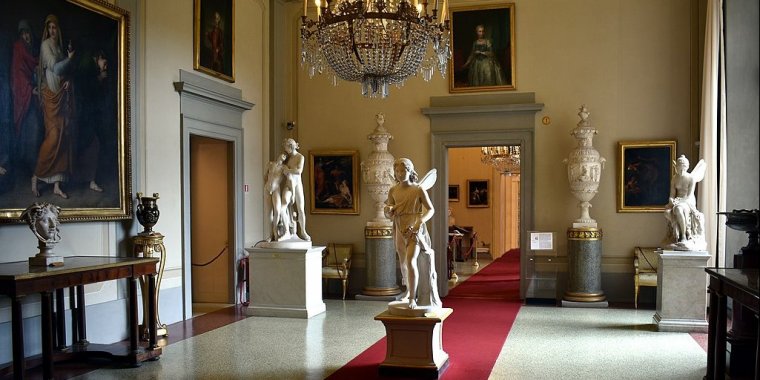
Galleria d'Arte Moderna in the Palazzo Pitti. ![]()
• Grandukes Treasury
The Silver Museum (Museo degli Argenti), now called "The Grandukes Treasury" (Tesoro dei Granduchi), contains a collection of priceless silver, cameos, and works in semi-precious gemstones, many of the latter from the collection of Lorenzo de' Medici, including his collection of ancient vases, many with delicate silver gilt mounts added for display purposes in the 15th century.
These rooms, formerly part of the private royal apartments, are decorated with 17th-century frescoes, the most splendid being by Giovanni da San Giovanni, from 1635 to 1636.
The Silver Museum also contains a fine collection of German gold and silver artefacts purchased by Grand Duke Ferdinand after his return from exile in 1815, following the French occupation.
• Porcelain Museum
First opened in 1973, this museum is housed in the Casino del Cavaliere in the Boboli Gardens. The porcelain is from many of the most notable European porcelain factories, with Sèvres and Meissen near Dresden being well represented.
Many items in the collection were gifts to the Florentine rulers from other European sovereigns, while other works were specially commissioned by the Grand Ducal court. Of particular note are several large dinner services by the Vincennes factory, later renamed Sèvres, and a collection of small biscuit figurines.
• Costume Gallery
Situated in a wing known as the "Palazzina della Meridiana [it]", this gallery contains a collection of theatrical costumes dating from the 16th century until the present. It is also the only museum in Italy detailing the history of Italian fashions. One of the newer collections to the palazzo, it was founded in 1983 by Kirsten Aschengreen Piacenti; a suite of fourteen rooms, the Meridiana apartments, were completed in 1858.
In addition to theatrical costumes, the gallery displays garments worn between the 18th century and the present day. Some of the exhibits are unique to the Palazzo Pitti; these include the 16th-century funeral clothes of Grand Duke Cosimo I de' Medici, and his wife Eleonora of Toledo and their son Garzia, both of whom died of malaria.
Their bodies would have been displayed in state wearing their finest clothes, before being reclad in plainer attire before interment.
The gallery also exhibits a collection of mid-20th century costume jewellery. The Sala Meridiana originally sponsored a functional solar meridian instrument, built into the fresco decoration by Anton Domenico Gabbiani.
• Carriages Museum
This ground floor museum exhibits carriages and other conveyances used by the Grand Ducal court mainly in the late 18th and 19th century. The extent of the exhibition prompted one visitor in the 19th century to wonder, "In the name of all that is extraordinary, how can they find room for all these carriages and horses".
Some of the carriages are highly decorative, being adorned not only by gilt but by painted landscapes on their panels. Those used on the grandest occasions, such as the "Carrozza d'Oro" (golden carriage), are surmounted by gilt crowns which would have indicated the rank and station of the carriage's occupants.
Other carriages on view are those used by the King of the Two Sicilies, and Archbishops and other Florentine dignitaries.
Source
• www.wikipedia.org
YOU MAY ALSO LIKE




